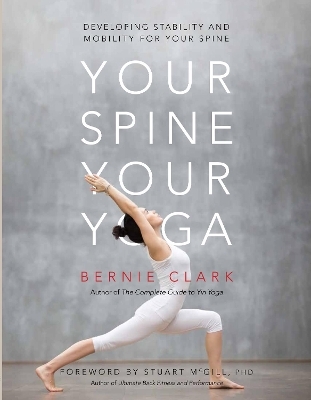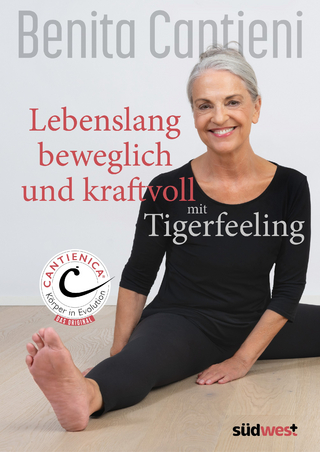
Your Spine, Your Yoga
Wild Strawberry (Verlag)
978-0-9687665-5-2 (ISBN)
both the Western anatomical/biomechanical point
of view and the modern yoga perspective. It is filled with detail, discussion, illustrations, and practical
advice for spines of all types. This emphasis on variety is welcome and necessary: no two spines are exactly
alike, and no two people have the same biology and biography. What your spine is able to do may be vastly
different from what other yoga students’ or teachers’ spines can do.
The human spine is unique in its
structure and function. Primarily, it provides stability through the core of our body, allowing forces
to be transmitted from the upper body (arms and shoulders) to the lower body (pelvis and legs) and
vice versa. Secondarily, the spine allows tremendous range of movement. Unfortunately, in modern yoga
practice we find the primacy of these two functions reversed, with flexibility prized over stability.
This focus on spinal mobility comes at a grave cost to many students. Stability is lost, and when that
happens, dysfunction and pain often follow.
Just as all tissues and areas of the body need a healthy
amount of stress to regain and maintain optimal health, so too our spine needs the appropriate levels
of stress to remain functional throughout our lives. How we choose to exercise the spine makes a
difference, though. Knowing the way the spine is built, specifically, how your spine is built, will
allow you to tailor your exercises wisely to match your goals.
Your Spine, Your Yoga is the second
book in the Your Body, Your Yoga series and focuses on the axial body―the core, from the sacral complex,
which includes the pelvis, sacrum, and sacroiliac joint, through the lumbar and thoracic segments of
the spine, to the cervical complex, which includes the neck and head. The structural components of
each segment are examined: from the bones, to the joints, ligaments, fascia, tendons, muscles, and
even the neurological and blood systems. The range and implications of human variations are presented,
as well as the ways these variations may affect individual yoga practices. The sources of restrictions
to movement are investigated through answering the question “What Stops Me?” The answers presented
run through a spectrum, beginning with various types of tensile resistance to three kinds of compressive
resistance.
Whether the reader is a novice to yoga, anatomy, or both, or a seasoned practitioner with
an in-depth knowledge in these fields, this book will be valuable. For the novice, there are easily
understood illustrations and photographs, as well as sidebars highlighting the most important topics.
For the anatomy geek, other sidebars focus on the complexity of the topic, with hundreds of references
provided for further investigation. For the yoga teacher, sidebars suggest how to bring this knowledge
into the classroom. Your Spine, Your Yoga can be used as a resource when specific questions arise,
as a textbook to be studied in detail, or as a fascinating coffee-table book to be browsed at leisure
for topics of current interest.
Bernie Clark author of the best selling The Complete Guide to Yin Yoga, has had a passion for science, health, sports and spirituality since childhood. He has a degree in science from the University of Waterloo and spent over 25 years as a senior executive in the high-tech/space industry. Bernie has been investigating the path of meditation for over three decades and began teaching yoga and meditation in 1998. He conducts yoga teacher trainings several times a year and aims to build bridges between the experiences of yoga and the understandings of modern science. He is creator of the YinYoga.com website. Other books written by Bernie include Your Body, Your Yoga; From the Gita to the Grail: Exploring Yoga Stories & Western Myths, as well as YinSights. Bernie lives, teaches and offers workshops in Vancouver, Canada. Dr. Stuart McGill is Professor Emeritus after 32 years at the University of Waterloo where he had a laboratory/clinic that explored low back pain, rehabilitation and performance enhancement. He has been the author of over 240 medical and scientific journal papers. This work has received several international awards including the “Volvo Bioengineering Award for Low Back Pain Research”. As a consultant, he has provided expertise on low back injury to various government agencies, many corporations and legal firms and professional/international athletes and teams world wide. He is regularly referred special and challenging patient cases from the international medical community for opinion. He has authored four books: "Gift of Injury" with Brian Carroll; "Back Mechanic" targeting the lay public with back pain; “Low Back Disorders: Evidence Based Prevention and Rehabilitation” designed for clinicians assessing and treating patients; and “Ultimate Back Fitness and Performance” targeting coaches and trainers. Timothy McCall, MD is a board-certified physician specializing in internal medicine, and the author of two books, Examining Your Doctor: A Patient's Guide to Avoiding Harmful Medical Care (Citadel Press) and Yoga as Medicine: The Yogic Prescription for Health and Healing (Bantam). He is co-editor of the first medical textbook on yoga therapy, The Principles and Practice of Yoga in Health Care (Handspring Publishing, 2016). He practiced medicine for more than 10 years in the Boston area before devoting himself full-time to investigating and teaching yoga therapy. Certified as a yoga therapist by the International Association of Yoga Therapists, he is the Founder/Director of Yoga As Medicine Seminars and Teacher Trainings and, until 2016, co-directed a yoga therapy center just outside of New York City.
Table of Contents for Your Spine, Your Yoga
Gratitude
How to read this book
Preface
Foreword
Summary of key concepts
Intentions
Chapter 1: The axial body
Overview of the axial body
Axial landmarks
Spinal segments
Variations of the spine
Curves of the spine
Posture perfect?
Bones of the axis
Ligaments and fascia
Movements of the spine
The kinds of stress in the spine
Spinal nerves and neurodynamics
Overview summary
Chapter 2: The sacral complex
Form
The architecture of the sacral complex
Bones and cartilage
Joints and ligaments
Muscles of the sacral complex
Fascial trains of the sacral complex
Function: Application in yoga postures
Normal ranges of motion within the sacral complex
Stressing and supporting the sacroiliac joint in yoga postures
Normal ranges of motion of the whole sacral complex
Sacral complex summary
Chapter 3: The lumbar segment
Form
The architecture of the lumbar segment
The bones of the lumbar segment
Axial fascia and muscles
Lumbar and thoracic muscles
Function: application in yoga postures
Normal ranges of motion
Sources of tension
Sources of compression
Variation in ranges of motion for flexion and extension
Yoga and the lumbar spine
The lumbar spine summary
The thoracic spinal segment
Form
The architecture of the thoracic spine
The bones of the thorax
Joints and ligaments
Thoracic fascia
Thoracic muscles
Function: application in yoga postures
Normal ranges of motion
Sources of tension
Sources of compression
Variation in ranges of motion for twists and side bends
Biomechanics of the breath and its variations
Thoracic spine summary
The Cervical Complex
Form
The Architecture of the cervical spine
The bones of the cervical complex
Joints and ligaments
Muscles of the cervical complex
Fascia of the cervical complex
Function: application in yoga postures
Normal ranges of motion
Movements and their restrictions: tensions and compressions
Variation in ranges of motion
Cervical spine summary
Volume 3: Summary
Major Sidebars
It’s important
The flaw of averages
The myth of the static ideal
Where is the neutral spine?
The myth of the static ideal
What does "stable" mean?
Early morning yoga and yoga after sitting
Stress, stretch, flexibility, mobility and hypermobility
Defining some terms
Yoga poses, sitting postures and sleeping position can overstretch nerves
Yoga and the sacral complex
In standing yoga postures, should we tuck the tailbone?
Defining the core muscles
Stiffness and stability
Our orientation to gravity affects the amount of stress on the spine
Different yoga postures stress the vertebral discs in different ways
Avoid twisting the spine when it is flexed or extended and under load
For deeper backbends, relax the extensor muscles!
Bracing and Spacing
Building endurance
Of bent knees and straight spines
Maintaining our vital capacity as we age
Slowing the breath is better than deepening the breath
Galileo, scaling laws and Headstand
The vertebral arteries
As you get older, be careful of weight bearing neck movements!
Returning the head to neutral
Shoulder stand—a high risk, low reward posture
Headstand—a high risk, low reward posture
It’s complicated
Statistics
Approximation and Distraction
Shear is stressful
Naming the nerves and their routes
The sciatic nerve
Force closure and form closure
Details of the sacrum
The perineum
The ways the sacrum moves
Does the sacrum nutate or counternutate in backbends?
Is it possible to therapeutically adjust the sacrum?
Changing the alignment of your hips before twisting
Snaps, cracks and pops—noisy sacrum
Lumbar lordosis in sports
Variations between the lumbar vertebrae
The spines of contortionists
Deep fascia and aponeuroses
The strength and stiffness of the spinal ligaments
A functional view of the erector spinae
The strength of the back muscles
How can our spines lift heavy loads?
How much stress can our spines tolerate?
Variations of the thoracic vertebrae
The diaphragm pulls and pushes on the heart
Membranes and ligaments between the skull and neck
Coupled movements
The neck does not move as one unit
Whiplash and sports trauma
Note to teachers
Learning to sense the spine
To hinge or not to hinge?
A philosophy for counterposes
Moola bandha and Kegel exercises
Can you feel relative movements of the ilia or of the sacrum?
Stress, twists and the sacroiliac joint
Don’t be fooled by the apparent curve in the lower back!
We cannot isolate and activate individual muscles
Watch your students!
Keep watching your students!
A flat back does not create a neutral spine
Strengthening the bones of the spine
Combatting hyperkyphosis
Sometimes it is okay to do only one side of a pose!
Variation in breast size will affect some women’s yoga practice
Movement can enhance breath, breath can enhance movement—sometimes!
Jalandhara bandha
Web appendices
Measuring the curves of the spine
Body size and spinal curves
Orientation of the facets
Creep and counterposes
Thickness of the discs and vertebral bodies
Hypermobility and Yin Yoga
Spinal biotensegrity
Variations in the shapes and sizes the auricular area of the sacroiliac joint
Pelvic parameters and variations
Accessory joints of the sacral complex
Myofascial meridians
Sacral, low back and neck pain and problems
Moment arms, torque and force
Wedging of the vertebrae and discs
Alignment of the spinous processes
Prying open the anterior discs in deep backbends
The thoracolumbar fascial train
More on the strength of the spinal ligaments
Folding forward with arms overhead increases stress in the spine
Axial rotation and lateral flexion can create flexion and extension
How yoga affects our blood chemistry
Other anterior neck muscles
Muscles of the face and jaw
| Erscheinungsdatum | 22.10.2018 |
|---|---|
| Vorwort | Dr. Stuart McGill |
| Zusatzinfo | Illustrations, unspecified |
| Verlagsort | BC |
| Sprache | englisch |
| Maße | 215 x 279 mm |
| Gewicht | 975 g |
| Themenwelt | Sachbuch/Ratgeber ► Gesundheit / Leben / Psychologie |
| Sachbuch/Ratgeber ► Sport ► Fitness / Aerobic / Bodybuilding | |
| ISBN-10 | 0-9687665-5-2 / 0968766552 |
| ISBN-13 | 978-0-9687665-5-2 / 9780968766552 |
| Zustand | Neuware |
| Haben Sie eine Frage zum Produkt? |
aus dem Bereich



